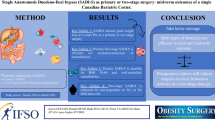Abstract
Purpose
The surgical management of neonates with duodenal atresia (DA) involves re-establishment of intestinal continuity, either by duodeno-duodenostomy (DD) or by duodeno-jejunostomy (DJ). Although the majority of pediatric surgeons perform DD repair preferentially, we aimed to analyze the outcome of DA neonates treated with either surgical technique.
Methods
Following ethical approval (REB:1000047737), we retrospectively reviewed the charts of all patients who underwent DA repair between 2004 and 2014. Patients with associated esophageal/intestinal atresias and/or anorectal malformations were excluded. Outcome measures included demographics (gender, gestational age, and birth weight), length of mechanical ventilation, time to first and full feed, length of hospital admission, weight at discharge (z-scores), and postoperative complications (anastomotic stricture/leak, adhesive obstruction, and need for re-laparotomy). Both DD and DJ groups were compared using parametric or non-parametric tests, with data presented as mean ± SD or median (interquartile range).
Results
During the study period, 92 neonates met the inclusion criteria. Of these, 47 (51%) had DD and 45 (49%) DJ repair. All procedures were performed open, apart from one laparoscopic DJ. Overall, DD and DJ groups had similar demographics. Likewise, we found no differences between the two groups for length of ventilation (p = 0.6), time to first feed (p = 0.5), time to full feed (p = 0.4), length of admission (p = 0.6), prokinetic use (p = 0.5), nor weight at discharge (p = 0.1). When the 30/92 (33%) patients with trisomy-21 (DD = 16, DJ = 14) were excluded from analysis, the groups still had similar weight at discharge (p = 0.2). Postoperative complication rate was not different between the two groups. One patient per group died, due to respiratory failure (DD) and sepsis (DJ).
Conclusions
This study demonstrates that in neonates with duodenal atresia, duodeno-duodenostomy and duodeno-jejunostomy have similar outcomes. These findings are relevant for surgeons who repair duodenal atresia laparoscopically, as duodeno-jejunostomy had equal clinical outcomes and may be easier to perform.
Similar content being viewed by others
References
Applebaum H, Sydorak R (2013) Duodenal atresia and stenosis—annular pancreas. In: Coran A, Adzick NS, Krummel T, Laberge JM, Shamberger R, Caldamone A (eds) Pediatric surgery, 7th edn. Elsevier, Philadelphia, pp 1051–1057
Gray SW, Skandalakis JE (1986) Embryology for surgeons: the embryological basis for treatment of congenital defects. WB Saunders, Philadelphia
Ernst NP (1916) A case of congenital atresia of the duodenum treated successfully by operation. Br Med J 1:644–645
Loitman C (1927) Congenital occlusion of the intestine. Boston Med Surg J 197:21–24
Ward CS, Cooper FW (1943) Atresia of the duodenum: a case successfully treated by duodenoduodenostomy. Ann Surg 117:718–722
Gross RE (1953) The surgery of infancy and childhood; its principles and techniques. WB Saunders, Philadelphia
Kimura K, Tsugawa C, Ogawa K et al (1977) Diamond-shaped anastomosis for congenital duodenal obstruction. Arch Surg 112:1262–1263
Stauffer UG, Irving I (1977) Duodenal atresia and stenosis—long term results. Prog Pediatr Surg 10:49–60
Spigland N, Yazbeck S (1990) Complications associated with surgical treatment of congenital intrinsic duodenal obstruction. J Pediatr Surg 25:1127–1130
Grosfeld JL, Rescorla FJ (1993) Duodenal atresia and stenosis: reassessment of treatment and outcome based on antenatal diagnosis, pathologic variance, and long-term follow-up. World J Surg 17:301–309
Bax NM, Ure BM, van der Zee DC et al (2001) Laparoscopic duodenoduodenostomy for duodenal atresia. Surg Endosc 15:217
Parmentier B, Peycelon M, Muller C et al (2015) Laparoscopic management of congenital duodenal atresia or stenosis: a single-center early experience. J Pediatr Surg 50:1833–1836
Author information
Authors and Affiliations
Corresponding author
Rights and permissions
About this article
Cite this article
Zani, A., Yeh, JP.B., King, S.K. et al. Duodeno-duodenostomy or duodeno-jejunostomy for duodenal atresia: is one repair better than the other?. Pediatr Surg Int 33, 245–248 (2017). https://doi.org/10.1007/s00383-016-4016-9
Accepted:
Published:
Issue Date:
DOI: https://doi.org/10.1007/s00383-016-4016-9




